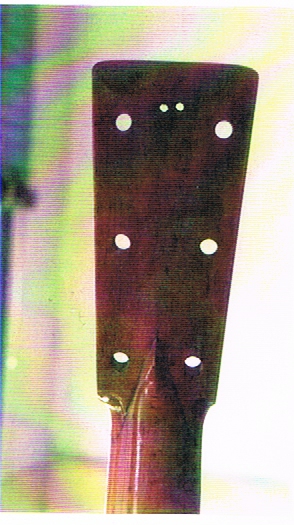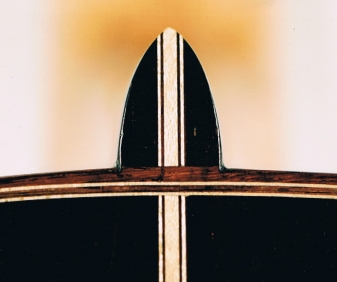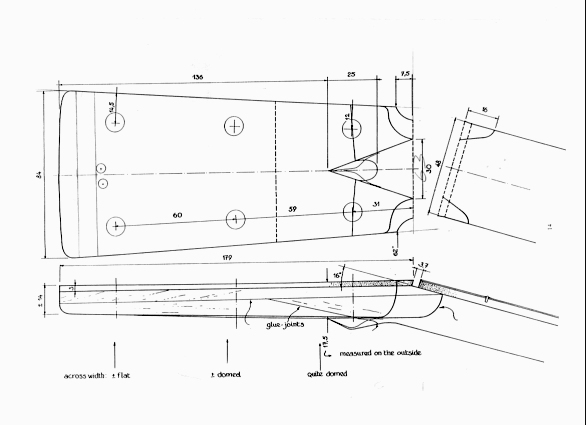I made the first copy of the Lorca guitar in 1996 or thereabouts. As mentioned I had examined the guitar and made my own drawing but my technical drawing skills and my guitar-making skills left a lot to be desired. For the first copy I had access to the instrument and the guidance of an expert luthier (Chacón) but for subsequent copies I think I really didn’t have very good information and had not taken a single photo of the original. Luckily, I later learned that Els Jageneau, a teacher at a guitar making school in Belgium had made a detailed drawing and a datasheet of the guitar. The photos she took as well as the detailed information was very helpful as I continued to make this replica. I will use some of her information here to illustrate the idiosyncrasies of this guitar. The full plan is available and consists of “a documentation drawing at full size in which the guitar is shown in different views . Next to it there is a appendix with technical information including photos” Please contact Ms. Jageneau for price and availability.
elsjageneau (at) skynet.be or Els Jageneau Schransstraat 19 2530 Boechout Belgium
Here is the typical purfling style of instruments of this era. I have never seen the right-angled mitres that we use today. In the photo above note the massive ends of the bridge, something not very common then or now.
Below you can see that the top has cracked right at the ends of the bridge, explaining why we tend to feather the bridge ends. Very interesting that another Lorca I have seen from 1871, made by his son, Antonio de Lorca Pino, has the same aesthetic and MOP decoration on the bridge but much lower and less massive bridge wings. They learned their lesson.
My solution to this problem in making replicas was the diamond shaped patch which so far has worked to stop the crack before it happens.
 This photo shows a lot of the other things I want to point out. The slipper foot is very long and wide to the point of doing away with a back bar in that region. The fan bracing with the common starting points for braces 1 and 2 as well as for 4 and 5 is present in some of the Pages instruments. The photo of the endblock purfling above also shows the curve of the top which is extreme even by today’s standards. It is more a cylindrical curve than a dome. I believe that this, along with the fan bracing, is what gives this guitar its special voice when compared to other romantic instruments (especially french, italian or german ones).
This photo shows a lot of the other things I want to point out. The slipper foot is very long and wide to the point of doing away with a back bar in that region. The fan bracing with the common starting points for braces 1 and 2 as well as for 4 and 5 is present in some of the Pages instruments. The photo of the endblock purfling above also shows the curve of the top which is extreme even by today’s standards. It is more a cylindrical curve than a dome. I believe that this, along with the fan bracing, is what gives this guitar its special voice when compared to other romantic instruments (especially french, italian or german ones).
 Below is a drawing from Ms. Jageneau’s notes that shows the true nature of the “V-joint” that is used in this gutar. It is actually a scarf joint with an extra cedar “headplate” under the ebony one and then a false diamond and V carved into the back. The neck blank was not thick enough to allow the diamond so an extra piece was glued on there. I have seen other instruments made like this but what is the intention? Some have suggested that he wanted to copy the V-joint or even Lacôte’s secret joint but didn’t know how. I personally doubt that he made this elaborate joint out of an inablility or lack of knowledge. The workmanship as a whole is very good and the acoustic result is also excellent.
Below is a drawing from Ms. Jageneau’s notes that shows the true nature of the “V-joint” that is used in this gutar. It is actually a scarf joint with an extra cedar “headplate” under the ebony one and then a false diamond and V carved into the back. The neck blank was not thick enough to allow the diamond so an extra piece was glued on there. I have seen other instruments made like this but what is the intention? Some have suggested that he wanted to copy the V-joint or even Lacôte’s secret joint but didn’t know how. I personally doubt that he made this elaborate joint out of an inablility or lack of knowledge. The workmanship as a whole is very good and the acoustic result is also excellent.



